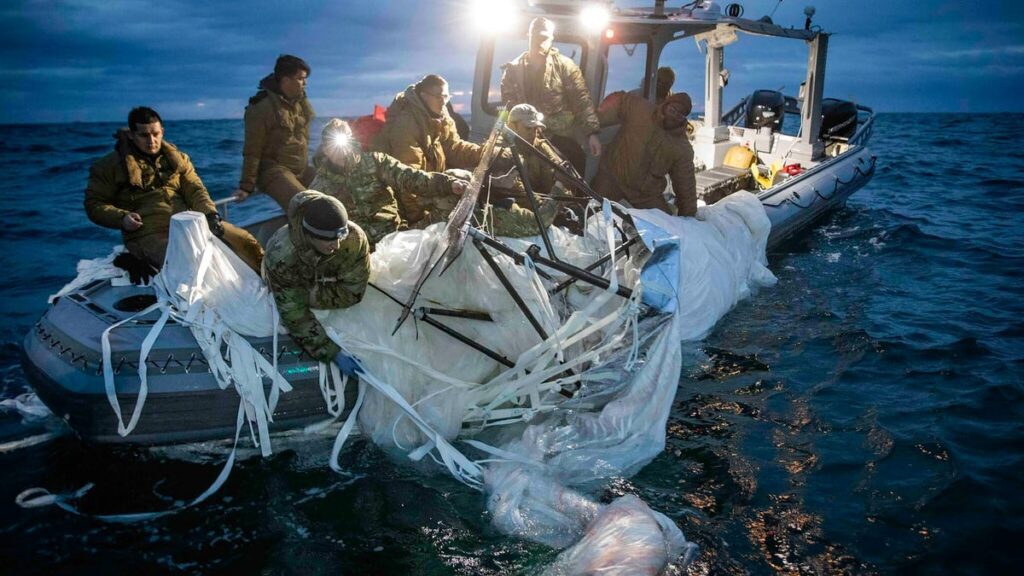Why the U.S. Is Suddenly Shooting Down So Many Balloons

In this photo provided by the U.S. Navy, sailors assigned to Explosive Ordnance Disposal Group 2 recover a high-altitude surveillance balloon off the coast of Myrtle Beach, S.C., Feb. 5, 2023. A missile fired on Feb. 5 by a U.S. F-22 off the Carolina coast ended the days-long flight of what the Biden administration says was a surveillance operation that took the Chinese balloon near U.S. military sites. It was an unprecedented incursion across U.S. territory for recent decades, and raised concerns among Americans about a possible escalation in spying and other challenges from rival China.Photo: U.S. Navy / Associated Press (AP)
At 2:42 pm Eastern on Sunday, February 12, mere hours before the Super Bowl kickoff, a pilot flying an F-16 fighter jet shot an AIM 9X missile at an airborne object 20,000 feet above Lake Huron. The pilot did so at the direction of President Biden and the Secretary of Defense, and the event marked the fourth shoot-down over U.S. airspace in eight days.
“Based on its flight path and data we can reasonably connect this object to the radar signal picked up over Montana, which flew in proximity to sensitive DOD sites,” reads a Department of Defense statement published February 12. “We did not assess it to be a kinetic military threat to anything on the ground, but assess it was a safety flight hazard and a threat due to its potential surveillance capabilities.”
While militaries have used balloons for war dating back to at least 1794, using balloons for covert peacetime surveillance is a relatively more recent phenomena. In the Cold War, the United States sent balloons with film cameras across the Soviet Union and China, hoping to capture evidence of massive military industrial undertakings. Project Genetrix, a program that launched over 400 balloons in early 1956, ended weeks after it started, with only 40 balloons recovered and a very incomplete picture derived from what they could see. Wind, as propulsion, can certainly carry lighter-than-air objects across the sky, but steering becomes difficult. The advent of high-altitude spy planes and then orbital satellite surveillance largely superseded the role of untethered surveillance balloons for military intelligence.
That better, more controllable options exist for military surveillance doesn’t change the reality that the U.S. is now apparently detecting and shooting down balloon-like objects in territorial skies.
During an on-the-record call with the press that occurred while the Super Bowl was on TV, General Glen VanHerck, Commander of North American Aerospace Defense Command (NORAD) and U.S. Northern Command (NORCOM), offered one explanation.
G/O Media may get a commission

BUNDLE AND SAVE
Samsung Presidents Day Appliance Sale
Save on refrigerators, washers and dryers, and more
The Samsung Presidents Day Sale event features price cuts and promotions on refrigerators, washers and dryers, vacuums, and much more. Unsure which pieces are worth your time? We’ve got a great selection here to choose from so you can pick up what best speaks to you before the sale ends on March 1.
“[R]adars essentially filter out information based on speed. So you can set various gates, we call them velocity gates, that allow us to filter out low-speed clutter. So if you have radars on all the time […] looking at anything from zero speed up to, say, 100, you would see a lot more information,” said VenHerck.
“We have adjusted some of those gates to give us better fidelity on seeing smaller objects. You can also filter out by altitude. And so, with some adjustments, we’ve been able to get a better a categorization of radar tracks now. And that’s why I think you’re seeing these overall. Plus, there’s a heightened alert to look for this information.”
One reason for the greater frequency of sightings is a deliberate recalibration of sensors to pick up more information. Radar systems, like those on jets or the ground based systems used by NORAD, are calibrated to detect the most relevant threats. NORAD, which was founded to watch the polar skies for incoming Soviet bombers or missiles, is designed to look for large, fast-moving objects, especially ones capable of carrying nuclear warheads. Adjusting the calibration on sensors means picking up other objects.
For a lower-stakes example, consider what happened on April 16, 2015, when political activist and postman Doug Hughes landed a gyrocopter on the east lawn of the United States Capitol Building. The man flew his small, ultralight vehicle through secure airspace, in violation of a No Fly Zone, and while he was only delivering letters, his flight path revealed gaps in what existing air defense radar can see. At a Congressional hearing afterwards, a Navy admiral noted that under existing filters, the Gyrocopter flight registered the same as either a small cloud or a flock of birds.
Changing the parameters of what can be seen means expanding what can and will be seen as a threat. It also calls into question whether such objects have transited above the U.S. in the past, evading detection because sensors were not calibrated to see them. After the first balloon was detected over Montana on February 1, the Department of Defense announced such balloons had been observed a few times before over the United States.
“I’m not currently tracking any other objects at this point. That doesn’t mean there couldn’t be more at some point in the future, but right now, we’re not seeing anything,” said VanHerck. “As far as, you know, previously […] I don’t know if there was more. We do know after the fact that there were high-altitude balloons because we went back and we were able to reconstruct them.”
Cross-continental balloon flight is slow, so if there has been a pause in launches, it will take some time for the already-launched balloons to pass. While balloons may not offer all the advantages of a satellite, there is one possible reason to use them, even if control and communication with balloons is limited.
“They can linger longer and get much more concentrated images much faster than a satellite,” writes Peter Harchter in the Sydney Morning Herald. “Two other advantages – they are so cheap that they’re expendable, and it turns out the U.S. couldn’t readily detect them for years. Beijing’s balloons were undetected or, at least, uncomprehended by the Americans for years.”
Still, before the balloon sightings and shootdowns end up as so much fuel for a new Cold War, it’s worth noting that, so far, the White House reports the observed objects were not even sending communication signals. If the objects were designed to probe defenses, it’s a strange omission to have them avoid communicating what, exactly, they discovered with their probes.



